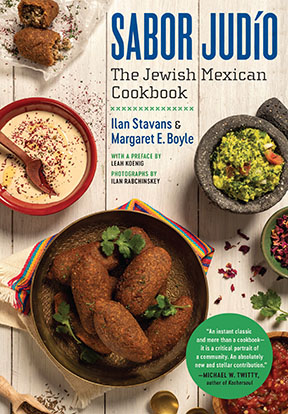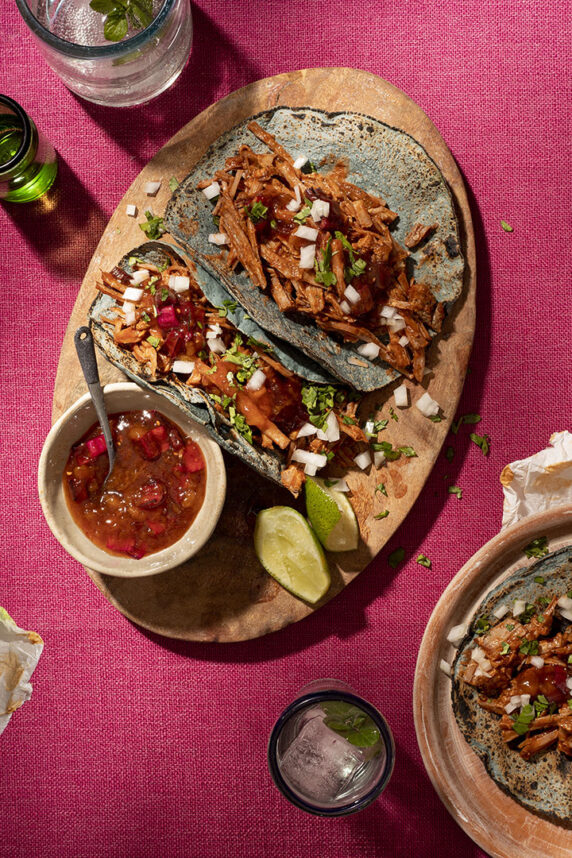
Ilan Stavans and Margaret Boyle’s “Sabor Judío: The Jewish Mexican Cookbook” fuses two beloved and meaningful culinary cultures.
“The book is a celebration of Jewish Mexican identity, but it also is a celebration of all diaspora identity and how people connect with culture and movement through food,” Boyle told the Journal.
 Featuring 100 personal recipes, enjoyed by Mexican Jews around the world, “Sabor Judío” shares the vibrant history of Jewish immigration to Mexico from 1492 to the present. Organized by meal, and including dishes made for Shabbat, Rosh Hashanah, Yom Kippur, Passover, Hanukkah, Shavuot and other holidays, it connects the past to the present and the future.
Featuring 100 personal recipes, enjoyed by Mexican Jews around the world, “Sabor Judío” shares the vibrant history of Jewish immigration to Mexico from 1492 to the present. Organized by meal, and including dishes made for Shabbat, Rosh Hashanah, Yom Kippur, Passover, Hanukkah, Shavuot and other holidays, it connects the past to the present and the future.
Stavans called it a “miracle.”
“It’s just astonishing that the anecdote about a cake or about a fish or about a soup can travel from people who are no longer with us, because they left these recipes,” Stavans told the Journal. “At some point [the next generation] will receive those recipes and adapt them in new and exciting ways.”
The authors spent a decade gathering recipes and personal narratives from Jewish Mexican households. Boyle is director of Latin American, Caribbean and Latinx Studies at Bowdoin College and associate professor of Romance Languages and Literatures. Originally from Mexico, Stavans is Lewis-Sebring Professor of Humanities and Latin American and Latino Culture at Amherst College and the publisher of Restless Books.
The pair of foodies met several years ago when Boyle invited Stavans to give a big talk in Jewish studies at Bowdoin.
“We learned, when we were getting to know each other, that we both had these recipe collections – me from my great grandmother and him from his grandmother – that were tied to our Jewish Mexican family,” Boyle said. “Because he is a big dreamer, he pushed us to do a call to the Mexican Jewish community to think about what recipes other families [were] carrying around.”
They were inundated with submissions, not just from modern fare, but recipes that had been around since the 15th and 16th century.
“It’s really a book about how different generations have migrated with food from one region of the world to another,” Stavans said. “And how the food has become an expression of their process of assimilation.”
Stavans explained that when families settled in Mexico, they discovered they needed to find new ingredients to bring into some of their recipes.
“There were challenges, but there were also new opportunities,” he said. “The extraordinary story of immigration is that it is never static … and food is [a] wonderful opportunity to understand those changes.”
They also discovered that many families carried around similar recipes.
“Even Ilan and I had [the same] cinnamon sugar, beer cookie … in both of his grandmother and my great grandmother’s recipe books,” Boyle said. “And we are pretty confident they never met each other, but the fact that they were cooking almost identical dishes is really amazing.”
Their recipe for brisket tacos, which is in the book, is below. The recipe fuses dishes prepared by the two matriarchs in Stavan’s and Boyle’s families, Anat Nurko and Phyllis Poplawski. Nurko prepared the three-chile marinade as learned from other women in her family, while Poplawski shared the rhubarb sauce joyfully passed down the generations.
Stavans hopes people go through “Sabor Judío” with a pen or marker in hand, so they can write their reaction to the recipes and start a dialogue.
“In my house, every time you open a cookbook, you will see my notes or my wife’s notes or my grandmother’s notes; we are all intruding and intervening,” he said. ”Hopefully readers and cooks … will do the same.”
Boyle echoed Stavans’ sentiments.
“What I also really love about the book is the way that we are telling stories about the history of immigration, about ingredients and where to find them,” Boyle said. “I am hopeful for that kind of non-linear reading that allows you to move between making a dish and learning something new about the history of the Mexican Jewish community and maybe about yourself.”
Learn more about “Sabor Judio,” Ilan Stavans at RestlessBooks.org and Margaret Boyle on the Bowdoin College website.
For the full conversation, listen to the podcast:

Brisket Tacos in Three-Chile Salsa with Phyllis’s Rhubarb
Serves 8–10
Preparation time: 45 minutes, plus marinating
Cooking time: 4 hours
For the Brisket:
3 cups water, plus more for covering
the chiles
3 dried pasilla chiles
3 dried ancho chiles
3 dried guajillo chiles
4 medium plum tomatoes (about
1 pound), cored, seeds removed, and roughly chopped
½ medium white onion, peeled and roughly chopped
2 medium garlic cloves, peeled and roughly chopped
2 ½ teaspoons kosher salt, plus more as needed
1 brisket (4–5 pounds)
For the Rhubarb Sauce:
2 large rhubarb stalks, cut into ½-inch pieces (about 2 cups)
⅓ cup granulated sugar
¼ cup water
For Serving:
Small (6-inch) corn tortillas, warmed
Chopped fresh cilantro
- Place the pasilla, ancho, and guajillo chiles in a medium saucepan and cover with water by a couple of inches. (The chiles will float to the top.) Set the saucepan over high heat, bring to a boil, and continue boiling until the chiles are soft, about 15 minutes. Drain and let cool to the touch.
- Wearing gloves, open each chile and remove the veins and seeds. Place the chile flesh and skin in a blender along with the tomatoes, onion, garlic, salt, and the 3 cups of water. Blend until smooth, then taste and add more salt, if needed.
- Place the brisket in a large baking dish or roasting pan, cover with the chile salsa, then cover tightly with aluminum foil. Refrigerate for at least 2 hours or up to overnight.
- Heat the oven to 325°F. Place the brisket in the oven and cook for 2 hours. Remove the baking dish, carefully flip the brisket over, and continue cooking until fork tender, about 2 hours. Remove from the oven and let rest for at least 30 minutes before slicing or shredding.
- Meanwhile, make the rhubarb sauce: Combine the rhubarb, sugar, and water in a small saucepan set over medium heat. Bring to a boil, stirring often, and cook until the liquid thickens and the rhubarb is tender, 5–10 minutes. Remove from the heat and let cool slightly, then use an immersion blender to purée until smooth. Allow the sauce to cool completely.
- To serve: Arrange the brisket in corn tortillas and top each taco with a little of the rhubarb sauce and chopped cilantro.
Debra Eckerling is a writer for the Jewish Journal and the host of “Taste Buds with Deb.” Subscribe on YouTube or your favorite podcast platform. Email Debra: tastebuds@jewishjournal.com.






















 More news and opinions than at a Shabbat dinner, right in your inbox.
More news and opinions than at a Shabbat dinner, right in your inbox.